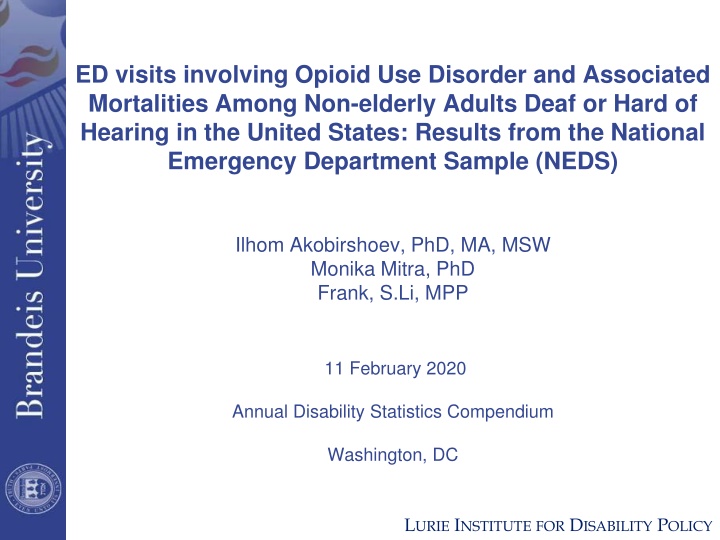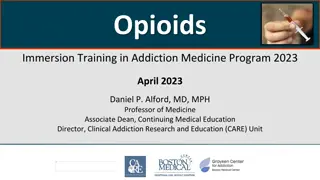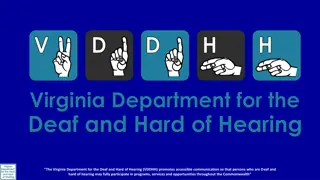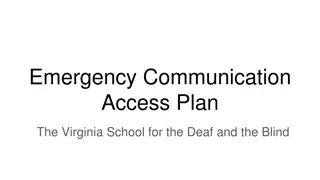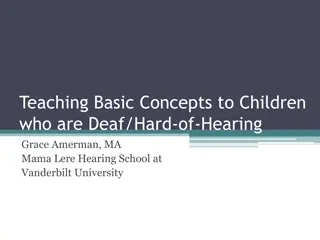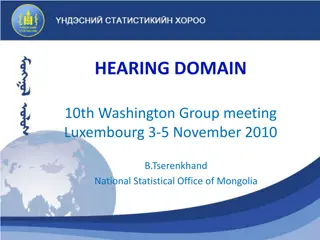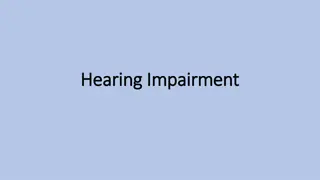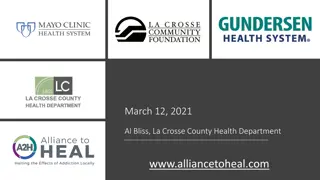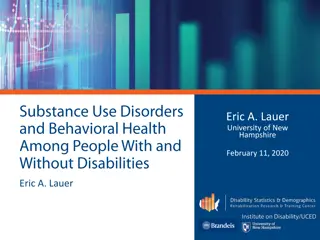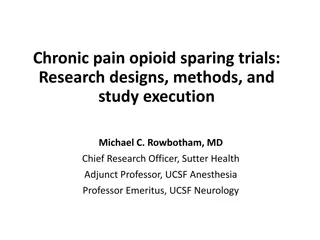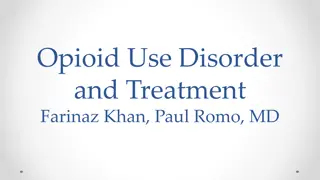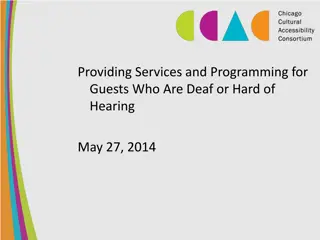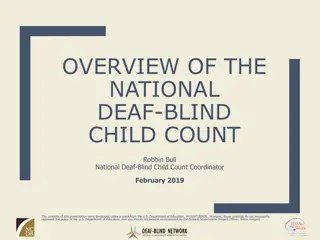Opioid Use Disorder and Mortality Among Non-elderly Deaf/Hard of Hearing Adults in the US
This study examined the risk of opioid use disorder (OUD) related emergency department (ED) visits and mortality among non-elderly adults who are deaf or hard of hearing (DHH) in the United States. Using data from the National Emergency Department Sample (NEDS), researchers found significant associations between DHH status and OUD-related ED visits, mortality during ED visits, and how sex could moderate these risks. The study's methods included analyzing clinical, demographic, and hospital-related factors using logistic regression models, providing valuable insights into the intersection of disability, addiction, and healthcare services.
Download Presentation

Please find below an Image/Link to download the presentation.
The content on the website is provided AS IS for your information and personal use only. It may not be sold, licensed, or shared on other websites without obtaining consent from the author.If you encounter any issues during the download, it is possible that the publisher has removed the file from their server.
You are allowed to download the files provided on this website for personal or commercial use, subject to the condition that they are used lawfully. All files are the property of their respective owners.
The content on the website is provided AS IS for your information and personal use only. It may not be sold, licensed, or shared on other websites without obtaining consent from the author.
E N D
Presentation Transcript
ED visits involving Opioid Use Disorder and Associated Mortalities Among Non-elderly Adults Deaf or Hard of Hearing in the United States: Results from the National Emergency Department Sample (NEDS) Ilhom Akobirshoev, PhD, MA, MSW Monika Mitra, PhD Frank, S.Li, MPP 11 February 2020 Annual Disability Statistics Compendium Washington, DC LURIE INSTITUTEFOR DISABILITY POLICY
Acknowledgment Funding support for this research was provided by NIDILRR, Grant #90DPGE0007-01-00. (PI Reif,S). INROADS: Intersecting Research on Opioid Misuse, Addiction, and Disability Services LURIE INSTITUTEFOR DISABILITY POLICY
Outline Background Research questions Method Results Conclusion LURIE INSTITUTEFOR DISABILITY POLICY
Background cont. ED visits for OUD and/or opioid overdoses rose 30% in all parts of the US from July 2016 through September 2017 (CDC) In 2017, among 70,237 drug overdose deaths, 47,600 (67.8%) involved opioids (CDC) Neither the CDC nor other public health care services reported on OUD-related ED visits and associated mortality among people with disability, including DHH individuals LURIE INSTITUTEFOR DISABILITY POLICY
Research Question Are DHH non-elderly adults have a higher risk for OUD-related ED visits? Are DHH non-elderly adults have higher risk for mortality during OUD-related ED visits? Is the risk of OUD-related ED visits and associated mortality in DHH non-elderly adults moderated by sex? LURIE INSTITUTEFOR DISABILITY POLICY
Methods Data 2016-2017 Nationwide Emergency Department Sample (NEDS) and part of the Healthcare Cost and Utilization Project (HCUP) databases ~33M ED records from about 1,000 hospitals 100+ clinical and nonclinical data elements Study sample Non-elderly adults (18-64) Analytical sample Cases: Non-elderly adults DHH: 63,835 DHH status was based on ICD-10-CM codes (H90xx and/or H91xx) Controls: Non-elderly adults without DHH: 638,350 (matched based on age and survey year in 1:10 case-control ratio) Outcomes OUD-related ED visit(ICD-10-CM codes and CPT/HCPCS codes) Prescribed opioid overdose-related ED visit (ICD-10-CM codes and CPT/HCPCS codes) Mortality during OUD-related ED visit Mortality during ED visits involving prescribed opioid overdose Covariates Sociodemographic (age, gender, insurance, income); hospital characteristics (rural/urban, teaching status, region); clinical characteristics (psychiatric comorbidities); Naloxone/Narcan Analysis Unadjusted and adjusted (stepwise) multivariable logistic regression models for binary outcomes Interaction analysis: Sex X DHH
RESULTS: Sample Characteristics for DHH and non-DHH Individuals Ages 18-64, United States, 2016 2017, N=702,185 DHH NON-DHH 55 49 36 35 33 31 29 29 28 26 26 21 21 20 17 16 15 12 Uninsured Medicare Medicaid Female $1-$38,999 $39,000-$47,999 $48,000-$62,999 Private insurance 63,000 + *** *** *** SEX INASURANCE PAYER TYPE MEDIAN INCOME BASED ON PATIENT'S ZIP CODE *p < .05; ** p < .01; *** p < .001 Covariates: age, race/ethnicity, type of health insurance, median household income for patients' zip code, number of Elixhauser medical comorbidities, hospital bed size and region of the hospital. LURIE INSTITUTEFOR DISABILITY POLICY
RESULTS: Sample Characteristics for DHH and non-DHH Individuals Ages 18-64, United States, 2016 2017, N=702,185 DHH NON-DHH 64 56 42 37 33 30 26 25 22 20 19 18 17 17 14 10 Non-metro hospital Yes Midwest Metro teaching South West Northeast Metro non-teaching *** *** *** HOSPITAL TEACHING STATUS HOSPITAL REGION PSYCH. DISORDERS LURIE INSTITUTEFOR DISABILITY POLICY
RESULTS: Unadjusted association between DHH status and OUD-related ED visits among U.S. non-elderly adults (18-64 years old), OR, N=702,185 OR=1.00 (referent: Non-DHH) *** *** 1.83 1.79 ** 1.18 0.89 DHH vs. non-DHH Moderation: DHH women vs. DHH men DHH vs. non-DHH Moderation: DHH women vs. DHH men OUD-related ED visit Prescribed opioid overdose-related ED visit *p < .05; ** p < .01; *** p < .001 Covariates: None LURIE INSTITUTEFOR DISABILITY POLICY
RESULTS: Adjusted (Model 1) association between DHH status and OUD-related ED visits among U.S. non-elderly adults (18-64 years old), OR, N=702,185 OR=1.00 (referent: Non-DHH) *** *** 1.55 1.54 ** 1.16 0.89 DHH vs. non-DHH Moderation: DHH women vs. DHH vs. non-DHH Moderation: DHH women vs. DHH vs. non-DHH DHH women vs. DHH men DHH men DHH vs. non-DHH DHH women vs. DHH men DHH men OUD-related ED visit OUD-related ED visit Prescribed opioid overdose-related ED visit Prescribed opioid overdose-related ED visit *p < .05; ** p < .01; *** p < .001 Covariates: age, type of health insurance, median household income for patients' zip code, hospital teaching status, and region of the hospital LURIE INSTITUTEFOR DISABILITY POLICY
RESULTS: Adjusted (Model 2) association between DHH status and OUD-related ED visits among U.S. non-elderly adults (18-64 years old), OR, N=702,185 OR=1.00 (referent: Non-DHH) *** *** 1.52 1.51 ** 1.15 0.89 DHH vs. non-DHH Moderation: DHH women vs. DHH vs. non-DHH Moderation: DHH women vs. DHH vs. non-DHH DHH vs. non-DHH DHH women vs. DHH men DHH women vs. DHH men DHH men DHH vs. non-DHH DHH vs. non-DHH DHH women vs. DHH men DHH women vs. DHH men DHH men OUD-related ED visit OUD-related ED visit OUD-related ED visit Prescribed opioid overdose-related ED visit Prescribed opioid overdose-related ED visit Prescribed opioid overdose-related ED visit *p < .05; ** p < .01; *** p < .001 Covariates: age, type of health insurance, median household income for patients' zip code, hospital teaching status, and region of the hospital, psychiatric disorders LURIE INSTITUTEFOR DISABILITY POLICY
Mortality during OUD- related ED visits
RESULTS: Unadjusted association between DHH status and mortality during OUD-related ED visits among U.S. non- elderly adults (18-64 years old), OR, N=702,185 * 3.57 OR=1.00 (ref: Non-DHH) *** 2.53 1.52 1.00 DHH vs. non-DHH Moderation: DHH women vs. DHH men DHH vs. non-DHH Moderation: DHH women vs. DHH men Mortality during OUD-related ED visit Mortality during prescribed opioid overdose-related ED visit *p < .05; ** p < .01; *** p < .001 Covariates: None LURIE INSTITUTEFOR DISABILITY POLICY
RESULTS: Adjusted (Model 1) association between DHH status and mortality during OUD-related ED visits among U.S. non-elderly adults (18-64 years old), OR, N=702,185 * 3.41 OR=1.00 (ref: Non-DHH) *** 2.27 1.51 0.99 DHH vs. non-DHH DHH vs. non-DHH DHH women vs. DHH men Moderation: DHH women vs. DHH men DHH vs. non-DHH DHH vs. non-DHH DHH women vs. DHH men Moderation: DHH women vs. DHH men Mortality during OUD-related ED visit Mortality during OUD-related ED visit Mortality during prescribed opioid overdose-related ED visit Mortality during prescribed opioid overdose-related ED visit *p < .05; ** p < .01; *** p < .001 Covariates: age, type of health insurance, median household income for patients' zip code, hospital teaching status, and region of the hospital LURIE INSTITUTEFOR DISABILITY POLICY
RESULTS: Adjusted (Model 2) association between DHH status and mortality during OUD-related ED visits among U.S. non-elderly adults (18-64 years old), OR, N=702,185 * 3.21 OR=1.00 (ref: Non-DHH) *** 2.23 1.49 0.98 DHH vs. non-DHH DHH vs. non-DHH DHH vs. non-DHH DHH women vs. DHH men DHH women vs. DHH men Moderation: DHH women vs. DHH men DHH vs. non-DHH DHH vs. non-DHH DHH vs. non-DHH DHH women vs. DHH men DHH women vs. DHH men Moderation: DHH women vs. DHH men Mortality during OUD-related ED visit Mortality during OUD-related ED visit Mortality during OUD-related ED visit Mortality during prescribed opioid overdose-related ED visit visit Mortality during prescribed opioid overdose-related ED visit Mortality during prescribed opioid overdose-related ED *p < .05; ** p < .01; *** p < .001 Covariates: age, type of health insurance, median household income for patients' zip code, hospital teaching status, and region of the hospital, psychiatric disorders LURIE INSTITUTEFOR DISABILITY POLICY
RESULTS: Adjusted (Model 3) association between DHH status and mortality during OUD-related ED visits among U.S. non-elderly adults (18-64 years old), OR, N=702,185 OR=1.00 (ref: Non-DHH) 2.30 1.45 1.37 0.85 DHH vs. non-DHH DHH vs. non-DHH DHH vs. non-DHH DHH vs. non-DHH DHH women vs. DHH men DHH women vs. DHH men DHH women vs. DHH men Moderation: DHH women vs. DHH men DHH vs. non-DHH DHH vs. non-DHH DHH vs. non-DHH DHH vs. non-DHH DHH women vs. DHH men DHH women vs. DHH men DHH women vs. DHH men Moderation: DHH women vs. DHH men Mortality during OUD-related ED visit Mortality during OUD-related ED visit Mortality during OUD-related ED visit Mortality during OUD-related ED visit Mortality during prescribed opioid overdose-related ED visit visit visit Mortality during prescribed opioid overdose-related ED visit Mortality during prescribed opioid overdose-related ED Mortality during prescribed opioid overdose-related ED *p < .05; ** p < .01; *** p < .001 Covariates: age, type of health insurance, median household income for patients' zip code, hospital teaching status, and region of the hospital, psychiatric disorders, Nalaxone/Narcane LURIE INSTITUTEFOR DISABILITY POLICY
Limitations cont. Accuracy of ICD-10 coding in the NEDS HCUP data DHH patients might not be coded by the ICD-10 as having DHH Missing data (income, health insurance) Unit of analysis is ED visit vs. patient Causal inference with cross-sectional data LURIE INSTITUTEFOR DISABILITY POLICY
Conclusions cont. First study of OUD-related ED visits and associated mortality among US non-elderly DHH adults Significant association b/w DHH status and OUD-related ED visits, including ED visits involving prescribed opioid overdose Sex is a moderator for OUD-related ED visits but not for ED visits involving prescribed opioid overdose Significant association b/w DHH status and mortality during OUD- related ED visit, including during ED visits involving prescribed opioid overdose Sex is not a moderator Administering Naloxone/Narcan during OUD-related ED visit, including during ED visits involving prescribed opioid overdose fully explained the risk of mortality in DHH non-elderly adults Need for more reserch
Thank you! Ilhom Akobirshoev ilhom@brnadeis.edu LURIE INSTITUTEFOR DISABILITY POLICY
Table 2. Risk for ED Visits Involving OUD and Associated Risk of Mortality for DHH and non-DHH ages 18-64, United States, 2016 2017 DHH Non-DHH Unadjusted Model 1 Model 2 Model 3 Outcomes N=63,835 N=638,350 Rate per 100,000 visits Rate per 100,000 Visits OR 95% CI OR 95% CI OR 95% CI OR 95% CI ED visits involving OUD or opioid overdose 2665 1502 1.80*** 1.70 - 1.89 1.55*** 1.47 - 1.64 1.52*** 1.44 - 1.60 ED visits due to prescribed opioid overdose 243 133 1.83*** 1.54 - 2.17 1.54*** 1.29 - 1.83 1.52*** 1.27 - 1.81 Died during ED visits for any reason 686 398 1.73*** 1.56 - 1.91 1.59*** 1.43 - 1.76 1.54*** 1.39 - 1.71 1.48*** 1.33 - 1.64 Died during OUD-related ED visits Died during ED visits involving prescribed opioid overdose 31.3 12.4 2.53*** 1.55 - 4.14 2.27** 1.38 - 3.74 2.23** 1.35 - 3.67 1.45 0.88 - 2.39 7.8 2.2 3.57* 1.29 - 9.92 3.41* 1.21 - 9.64 3.20* 1.13 - 9.10 2.30 0.80 - 6.60
